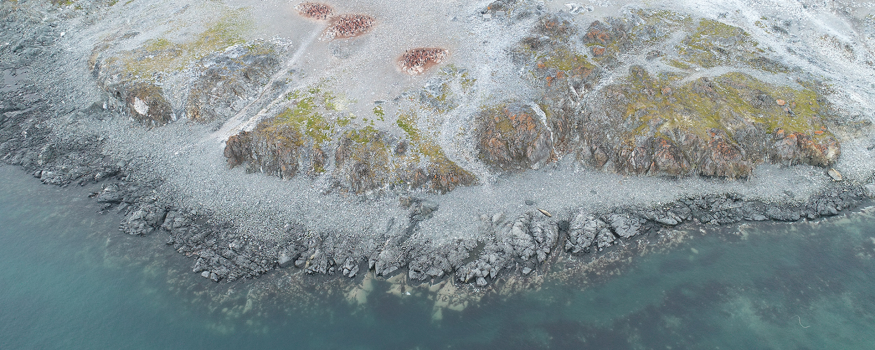
Drones, Data and Discovery: Mapping Change in Antarctica
When Greg Larsen came to Duke as a doctoral student in marine science and conservation, he connected with Professor David Johnston, who had just renovated the boathouse at the Duke Marine Lab to turn it into a drone lab.
Drones are an efficient tool for marine researchers to collect large amounts of high-quality data. Larsen had a background in studying seals and no experience using drones, but he saw the potential to explore new topics with seals.
Along with research skills, he had to learn the legal part of drone piloting and study Federal Aviation Administration (FAA) rules. After getting his FAA certification, the next step was to practice with an experienced pilot and learn the ins and outs of drone safety.

“Battery maintenance is important in learning the art of how to safely fly a drone,” Larsen said. “If the wind picks up, do you have enough battery to hover in place before getting your drone out of there?” Again and again, he practiced getting disoriented, losing sight of his drone and finding it quickly, to simulate challenging field conditions.
Getting involved in a grant to use drones to study whales in Antarctica, Larsen headed south with a chance to develop his own research plan. “Dave [Johnston] said, your job is to collect whale data,” Larsen summarized. “You’re there with drones, so try to figure out other projects.”

Larsen and some colleagues conducted weekly drone surveys of several islands near Palmer Station, where weather patterns have been shifting from cold, dry and predictable to warmer, wetter and more variable. Team members at the Palmer Antarctica Long-Term Ecological Research program studied how whales and other species are responding to this ecological shift.
In addition to whales, Larsen began focusing on seals, but he ended up finding more than he imagined during three summers. “The third year was a big success,” he said. “We were creating incredible maps showing vegetation, glacial melt and wildlife.”

Excited by the scope of rich data, Larsen and Johnston sought to bring students into the mix. “We thought, we have all this amazing imagery, let’s design a project and explore these dimensions of the data,” Larsen said. “That led to designing a Bass Connections project around this.”
Duke’s Bass Connections program brings faculty, graduate students and undergraduates together in the exploration of societal challenges. Most of these interdisciplinary research teams have external partners and last for two semesters.
Larsen and Johnston called the project Biogeographic Assessment of Antarctic Coastal Habitats. “The first semester was lectures and an introduction to the topic and to GIS to build the intellectual and skills frameworks,” Larsen said. “In the second semester, we encouraged students to develop their own projects. We seeded some projects and encouraged students to work in pairs or threes. It was an incredible opportunity to probe deeper into the data, and students seemed to really enjoy learning about Antarctica.”

Student projects zeroed in on fur seals, elephant seals, Adélie penguins and giant petrels as well as land cover changes such as retreating glaciers and blooming vegetation.
“As an outcome of the Bass Connections project, we were able to publish a data repository [Aerial data from drone surveys of coastal habitats on the West Antarctic Peninsula] that continues to be used by Antarctic scientists,” Larsen said.

Hanna Varga, a graduate student in civil and environmental engineering, was a co-first author on a paper in Polar Biology on giant petrel nests. Other papers related to the team’s work have been published in Ecology and Evolution on fur seals near Palmer Station and Landscape Ecology on Adélie penguin colony extinctions.
“I had such a great experience working with Greg on the Bass Connections project,” said Zoe Wong, a student team member who received her master’s degree in environmental management. “I wanted to join the project because it gave me a chance to develop more technical GIS skills and undertake original research about penguin colony behavior. The technical skills and research experience I gained have given me a deep understanding of scientific research. That depth of understanding now informs my current work advising a member of Congress on environmental and science policy and allows me to develop smarter, more well-rounded policy proposals.”
Johnston said that “Bass Connections has been a key component of my lab’s research, as well as a really important part of my teaching. I’ve been a leader on several Bass Connections teams and contributed to others, and this work has led to deeply rewarding experiences both for the students and myself.”
Three years later, Larsen is currently a biologist with the National Park Service, continuing to use drones and mapping skills to study wildlife for the parks of Southeast Alaska. He remains involved in collaborations with Johnston and with colleagues from Antarctica, occasionally still using the data that he collected with Duke and explored through Bass Connections.

Main image: Landmass near Palmer Station, Antarctica (Photo: Courtesy of Greg Larsen)
